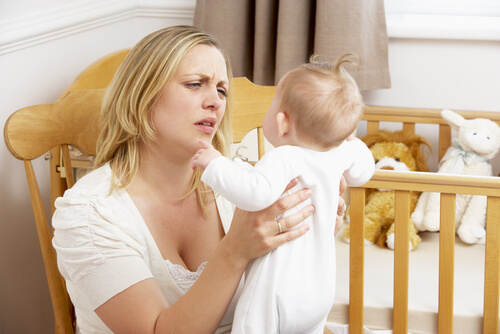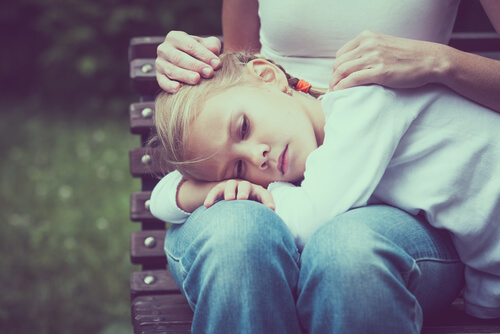Childhood Depression: Causes, Prevention and Treatment

It may seem impossible to imagine that children – immersed in a world of games and adventures – could become depressed. However, the reality is sadly different.
Childhood depression exists, and medical professionals consider it an illness. Even newborns can fall victim to depression, releasing strong feelings of unhappiness.
The biggest problem with childhood depression is that it can go unnoticed.
Often, children don’t even understand what’s happening to them. They face emotions and feelings they don’t know how to express, and much less overcome.
Although their symptoms may seem like signs of weakness, they’re actually signs of a dangerous emotional disorder.
- Apathy.
- Agression.
- Nostalgia.
- Lack of motivation.
- Low self-esteem.
- Mood swings.
These are some of the clearest indicators of depression among children.
However, there may be much more to it. Personal conflicts, psychological alterations and illnesses can remain hidden for quite some time.
What causes childhood depression?
Brain chemistry, biology, life experiences, physical health… Depression can involve many factors.
But when it comes to children, there is one factor that makes them especially vulnerable: Their immaturity when it comes to controlling their emotions.
Associated risk factors:
- Environment (social and family).
- Genetic predisposition. According to clinical studies, if parents suffer from depression, their children are four times more likely to receive the same diagnosis.
An intolerance towards frustration or demanding rewards for actions can also cause children to become depressed. At the same time, children who suffer mistreatment, abuse or loss are also more prone to depression.
How to determine if a child is depressed
Childhood depression can be evidenced clinically and emotionally. Sadness is one indication, but it isn’t the most significant one.
Depression refers to the presence of one or several of the following symptoms for more than 2 consecutive weeks (without the effect of any substance):
- Feelings of guilt.
- Hostility, irritability, anger.
- Self-destructive ideas or behavior.
- Physical discomfort without a medical explanation.
- Changes in weight, with no apparent cause.
- Feelings of emptiness, hopelessness.
- Agitation or inhibition of psycho-motor activity.
- Sleeping problems, difficulty concentrating.
- Apathy, loneliness, negativity, a tendency to cry or yell.
- Inability to enjoy school or recreational outings.
- Despondency, lack of energy, refusal to speak, poor academic performance.
Babies can also suffer from depression

A baby’s body comes prepared with emotional, sensory and motor competencies that help him process the information he receives.
When babies come into the world, they cling to those that offer them protection and survival. The more satisfying and loving these connections are, the happier babies will be.
If, on the other hand, babies encounter rejection, lack of affection (especially from the mother), then depression is imminent.
What are the manifestations of depression in babies? Apathy, suppressed crying, lack of laughter, lack of response to stimuli, attachment to strangers.
If an 8-month-old baby prefers being in the arms of a stranger than in the arms of his own parents, something is amiss. The same if the child is quiet, not wanting to explore the world around him, or worse, if the child digresses in his development.
If around 17-18 months of age a child doesn’t walk, or at 2 he still doesn’t say a single word, this may also be a sign of depression. These factors are often the result of depressed parents.
How to diagnose and treat depression in children

There is no specific method for detecting depression in children. Conversations and consultations with mental health professionals as well as an evaluation of your child’s symptoms will help to establish a diagnosis.
The strategy will vary according to the child’s age.
A child who suffers from depression should receive individualized treatment that adapts to his stage of development, behavior, emotional maturity and cognitive function.
There are dynamic and systemic therapies for identifying pathological parameters of interaction. Based on these parameters, the specialist will choose treatment techniques, which in some circumstances may include medication.
It’s key that adults be understanding and compassionate. Care, respect and the encouragement of healthy social interaction are fundamental in children’s lives.
It may seem impossible to imagine that children – immersed in a world of games and adventures – could become depressed. However, the reality is sadly different.
Childhood depression exists, and medical professionals consider it an illness. Even newborns can fall victim to depression, releasing strong feelings of unhappiness.
The biggest problem with childhood depression is that it can go unnoticed.
Often, children don’t even understand what’s happening to them. They face emotions and feelings they don’t know how to express, and much less overcome.
Although their symptoms may seem like signs of weakness, they’re actually signs of a dangerous emotional disorder.
- Apathy.
- Agression.
- Nostalgia.
- Lack of motivation.
- Low self-esteem.
- Mood swings.
These are some of the clearest indicators of depression among children.
However, there may be much more to it. Personal conflicts, psychological alterations and illnesses can remain hidden for quite some time.
What causes childhood depression?
Brain chemistry, biology, life experiences, physical health… Depression can involve many factors.
But when it comes to children, there is one factor that makes them especially vulnerable: Their immaturity when it comes to controlling their emotions.
Associated risk factors:
- Environment (social and family).
- Genetic predisposition. According to clinical studies, if parents suffer from depression, their children are four times more likely to receive the same diagnosis.
An intolerance towards frustration or demanding rewards for actions can also cause children to become depressed. At the same time, children who suffer mistreatment, abuse or loss are also more prone to depression.
How to determine if a child is depressed
Childhood depression can be evidenced clinically and emotionally. Sadness is one indication, but it isn’t the most significant one.
Depression refers to the presence of one or several of the following symptoms for more than 2 consecutive weeks (without the effect of any substance):
- Feelings of guilt.
- Hostility, irritability, anger.
- Self-destructive ideas or behavior.
- Physical discomfort without a medical explanation.
- Changes in weight, with no apparent cause.
- Feelings of emptiness, hopelessness.
- Agitation or inhibition of psycho-motor activity.
- Sleeping problems, difficulty concentrating.
- Apathy, loneliness, negativity, a tendency to cry or yell.
- Inability to enjoy school or recreational outings.
- Despondency, lack of energy, refusal to speak, poor academic performance.
Babies can also suffer from depression

A baby’s body comes prepared with emotional, sensory and motor competencies that help him process the information he receives.
When babies come into the world, they cling to those that offer them protection and survival. The more satisfying and loving these connections are, the happier babies will be.
If, on the other hand, babies encounter rejection, lack of affection (especially from the mother), then depression is imminent.
What are the manifestations of depression in babies? Apathy, suppressed crying, lack of laughter, lack of response to stimuli, attachment to strangers.
If an 8-month-old baby prefers being in the arms of a stranger than in the arms of his own parents, something is amiss. The same if the child is quiet, not wanting to explore the world around him, or worse, if the child digresses in his development.
If around 17-18 months of age a child doesn’t walk, or at 2 he still doesn’t say a single word, this may also be a sign of depression. These factors are often the result of depressed parents.
How to diagnose and treat depression in children

There is no specific method for detecting depression in children. Conversations and consultations with mental health professionals as well as an evaluation of your child’s symptoms will help to establish a diagnosis.
The strategy will vary according to the child’s age.
A child who suffers from depression should receive individualized treatment that adapts to his stage of development, behavior, emotional maturity and cognitive function.
There are dynamic and systemic therapies for identifying pathological parameters of interaction. Based on these parameters, the specialist will choose treatment techniques, which in some circumstances may include medication.
It’s key that adults be understanding and compassionate. Care, respect and the encouragement of healthy social interaction are fundamental in children’s lives.
All cited sources were thoroughly reviewed by our team to ensure their quality, reliability, currency, and validity. The bibliography of this article was considered reliable and of academic or scientific accuracy.
- Saklofske, D. H., Hildebrand, D. K., & Kaufmann, L. (1998). Depresión en los niños. Helping Children at home and school: handouts from your school psychologist, 237-240. http://www.infocop.es/pdf/Depresionniños2017.pdf
- Montenegro, H. (1993). Depresión en la infancia y adolescencia. Rev. chil. neuro-psiquiatr, 31(1), 13-23. http://bases.bireme.br/cgi-bin/wxislind.exe/iah/online/?IsisScript=iah/iah.xis&src=google&base=ADOLEC&lang=p&nextAction=lnk&exprSearch=135503&indexSearch=ID
- Del Barrio, V., Navarro, M. D. F., & Escrivá, M. V. M. (1994). Autoestima y depresión en niños. Revista de psicología general y aplicada: Revista de la Federación Española de Asociaciones de Psicología, 47(4), 471-476. https://dialnet.unirioja.es/descarga/articulo/2385363.pdf
This text is provided for informational purposes only and does not replace consultation with a professional. If in doubt, consult your specialist.








